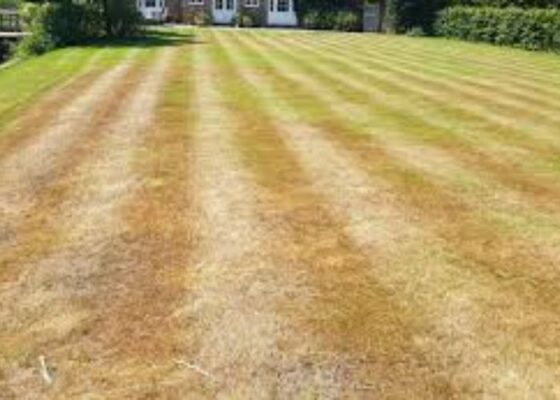As a lawn care professional with over 7 years of experience, I’ve seen my fair share of dry spells and drought conditions that can really take a toll on lawns. When hot, dry weather persists for weeks or months on end, grass can become dried out, discolored, or even die. However, with some careful planning and lawn care techniques, you can help your lawn survive and even thrive during times of drought. Read below “Dry Weather? How to Protect Your Lawn During Drought Conditions”.
In this article, I’ll share my top tips for protecting your lawn during dry weather and drought based on my extensive experience in the lawn care industry.
Table of Contents
Monitor Soil Moisture Carefully

The key to keeping your lawn healthy during drought is carefully monitoring and maintaining proper soil moisture levels. I recommend investing in a soil moisture meter which will allow you to easily check moisture levels in different parts of your yard. Take readings 2-3 times per week and water when the top few inches become dry. Pay extra attention to hot spots that dry out more quickly, like areas along driveways or near buildings.
Adjust Your Watering Schedule
During normal weather, established lawns need about 1 inch of water per week from rain or irrigation. But in dry conditions you’ll need to increase watering to compensate for lack of rainfall. I generally recommend watering an extra 1⁄2 inch 2-3 times per week during drought to maintain soil moisture. Water early in the morning to reduce evaporation loss. And avoid frequent light watering, which encourages shallow roots. Instead, water deeply and infrequently to encourage deeper root growth.
Raise Your Mower Blade
Letting your grass grow slightly taller—around 3-4 inches—will provide more shade for the soil, reducing evaporation. Raising your mower blade can help accomplish this easily. The extra height also promotes deeper root growth, making your lawn more drought resistant. Just be sure not to remove more than 1/3 of the blade height when mowing, to avoid lawn stress.
Aerate Compacted Soil
Compacted soil prevents water from penetrating deeply into the roots. Aerating will loosen up the soil and allow for better water absorption. Use a core aerator to remove plugs of soil 2-3 inches deep. Focus on high traffic areas that are often compacted. For best results, aerate at the start of the dry season so your lawn can better absorb water all season long.
Use a Mulching Mower
Mulching mowers chop up grass clippings into tiny pieces that are left to decompose on the lawn. This returns moisture and nutrients back to the soil. By using a mulching mower during drought, you can reduce water loss and improve soil health. Set blades to cut off only the top 1/3 of grass blades for easiest mulching.
Add Organic Matter
Adding a thin layer of compost over your lawn can help soil retain more moisture. The organic matter acts like a sponge, preventing water loss. Compost also adds nutrients that improve the soil’s ability to absorb and hold water. Apply a 1⁄4 inch layer of compost over the lawn in early spring or fall.
Reduce Traffic and Activity
Foot traffic, play activity, and high use areas can all compact the soil, damage grass blades, and cause excess water loss. Try to minimize activity on the lawn during extreme heat and drought to reduce lawn stress. If you must use certain high traffic areas, water them more frequently to maintain soil moisture.
Adjust Your Fertilizer Program
Fertilizing encourages new lawn growth, which requires extra water. So avoid pushing top growth during drought with high nitrogen fertilizers. Instead use slow release or natural organic fertilizers that provide a slow, steady supply of nutrients with less surge growth. Your lawn will still build strong roots and crowns that help it withstand drought stress.
Check Irrigation System Health
Ensure sprinklers are providing uniform, efficient coverage with no leaks or malfunctions. Patch or adjust any problem areas that could be wasting water and preventing adequate irrigation. Inspect spray patterns monthly and fix tilted or clogged heads. Repair leaks quickly to avoid losing precious water.
Reduce Evaporative Loss
Wind and high temperatures cause faster evaporation of water from lawns. To minimize this, avoid watering during the heat of mid-day. Water in the early morning or evening when temperatures are cooler. Windbreaks like trees and shrubs can also reduce evaporative water loss. Use sprinklers with a finer droplet size, which are less prone to drift and evaporation.
Let Lawn Go Dormant
If drought persists for many weeks and water restrictions are in place, you may need to let your lawn go dormant. Dormancy is a survival mechanism that allows grass to become brown and inactive to withstand extreme drought. While dormant, it is crucial to water just enough to maintain root viability – about 1⁄4 inch every 2-3 weeks. Dormant grass will bounce back and regreen once normal rains return.
Overseed with Drought-Resistant Grass
Consider overseeding thin or bare areas of your lawn with drought-resistant grass varieties. Tall fescue and fine fescues have very deep root systems that access water far below the surface. Buffalograss and Bermudagrass also withstand drought well. These can help strengthen your lawn for dry conditions now and in the future.
In Conclusion
Extended periods of dry, hot weather can certainly damage lawns. But by taking proactive steps to maintain soil moisture, reduce water loss, and strengthen grass plants, you can help your lawn survive and recover from drought. As a lawn care professional, I’ve used all of these best practices successfully to protect lawns through tough dry spells. Monitoring soil moisture, adjusting your watering schedule, and promoting deep root growth are all key elements of a drought resistant lawn care plan. With some extra TLC, your lawn can make it through the dog days of summer and stay healthy.

Barry, the expert behind LawnInspection.com, holds a Master’s degree in Horticulture and brings over 20+ years of hands-on experience in landscaping and lawn care. With certifications in sustainable lawn management, Barry is dedicated to providing readers with authoritative insights and practical tips for maintaining lush, healthy lawns. His extensive knowledge and commitment to excellence ensure that every piece of advice on LawnInspection.com helps transform your lawn into a green oasis with proven, eco-friendly practices. Connect with Barry on social media: Instagram and Facebook.









